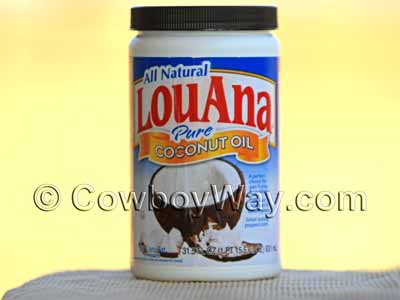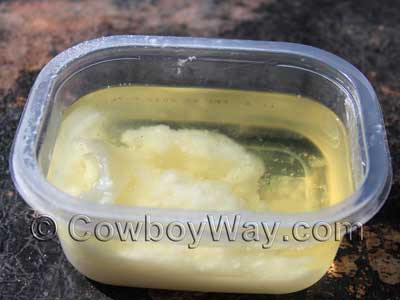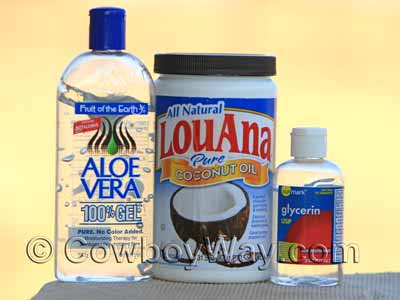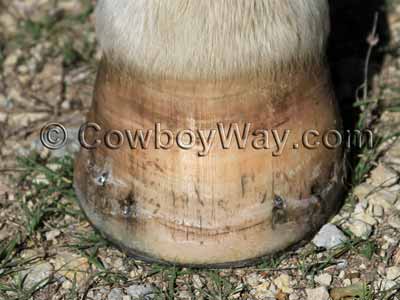How To Make Homemade Horse Hoof Conditioner
When an extreme, long-term drought hit our area we tried several different brands of store-bought hoof conditioners with little or no noticeable results.
Before the drought we hadn't used hoof conditioner on our horses; their hooves were healthy without it. However, as the drought continued our horses' hooves became increasingly dry and brittle.
One by one we tried several different brands of store-bought hoof conditioners without any noticeable improvement.
Below: Coconut oil.

Finally, we decided to try making our own hoof conditioner. After some research we decided to base our homemade hoof conditioner on coconut oil, a common product that is popular for cooking as well as for topical use.
We decided to try using the coconut oil in two different ways:
- By itself, and
- As part of a mixture of two parts coconut oil, one part glycerin, and one part aloe vera gel.
We wanted to know if the coconut oil, by itself, would work as a hoof conditioner, or if the mixture was more (or less) effective than the coconut oil alone.
The winner, in our opinion, was the coconut oil by itself. It worked very well and very quickly, eliminating the extreme brittleness of our horses' hooves in a short amount of time without making them soft or spongy.
While the mixture of coconut oil, glycerin, and aloe vera gel also worked, it didn't seem to offer any benefits over the coconut oil alone. Details are in the article below.
The Homemade Hoof Conditioner Experiment
Recipe #1: Coconut oil. That's all, just coconut oil.
Coconut oil is a solid at approximately 76 degrees Fahrenheit and below, but melts to a liquid at temperatures above that. While it is most commonly known as a cooking oil it is also also popular for topical use and as an ingredient in a wide variety of cosmetic products such as skin and hair conditioners.
It is also an ingredient in some commercially available hoof dressings, such as Hoofmaker (which is a brand we didn't try, by the way).
Below: Partially melted coconut oil in a clear container.

Recipe #2: A mixture of two parts coconut oil, one part glycerin, and one part aloe vera gel.
The mixture never really mixed very well. In spite of high summer temperatures we had to shake it and stir it vigorously every time we used it, and it would separate again almost immediately.
Below: The ingredients for recipe #2.

Horses Used
For our test we used three different horses. We put straight coconut oil on the front hooves on their left sides, and the mixture on the front hooves on their right sides. As a sort of experimental control, we did not put anything, homemade or store bought, on the hind hooves.
Where Applied
Using a 1-inch wide paint brush we applied a light coat of the conditioners to the outside of the hoof wall and the coronary band, going up approximately 1/2 inch into the hairline. We also applied a light coat of the conditioners to the bulbs of the heel, frog, and sole.
We kept the horses out of the pasture for at least 30 minutes after applying the hoof conditioners so that they wouldn't immediately be rubbed off by the grass.
Surprisingly Fast Results
For the first week we treated the horses' hooves for five out of seven days. On the seventh day the horseshoer came to trim and reset the horses. After he was finished we asked him what he thought about the condition of their hooves.
Below: Day 0. This is one of the horse's hooves before we started applying coconut oil as a hoof conditioner. Notice the cracks, particularly around the nail holes. In addition, notice the dry, cracked appearance of the coronary band at the top of the photo.

He stated that the front feet were in good condition but that the back feet weren't. When we asked him to be more specific he said the front feet trimmed easily all the way around, usually in one piece.
The back feet, though, chipped off piece by piece. He said that the front feet rasped smoothly but that the back feet splintered. He also said that when he drove nails into the front feet the nails drove predictably, whereas on the back feet the nails wanted to bounce and sort of ricochet if he wasn't careful.
When we asked him if he had noticed any difference between the left front feet of the horses (the coconut oil only side) compared to the right front feet (the coconut oil, glycerin, and aloe vera mixture side), he said no, they seemed the same to him.
Before he left, he told us to keep doing whatever it was we were doing but to do it to the back feet, too.
Continued Use
After the first week, even though the drought was continuing with high heat, drying winds, and no moisture, we were concerned we could overdo the use of hoof conditioners. So, after the first week, we backed off to applying the conditioners only three days per week instead of five.
This is still heavy use of hoof conditioners, but we thought our extreme drought conditions warranted it.
Below: The same horse's hoof as shown in the photo above, 51 days after regular application of coconut oil as a hoof conditioner. Notice the decreased appearance of cracks. Also, notice that the coronary band no longer has a dry, cracked appearance.

When we ran out of the coconut oil, glycerin, and aloe vera mixture we didn't make any more. The straight coconut oil was working just as well on its own, and was easier to apply. We also began applying the coconut oil to all four feet on each horse, not just the front feet (which our shoer immediately noticed).
As summer gave way to fall we did experience a few small dews, but no significant rain. If we felt the dews were long-lasting in the mornings, we skipped applying coconut oil that day. Therefore, throughout the fall our use of the coconut oil varied between one and two days per week.
During the winter the coconut oil became more difficult to use. Coconut oil is a solid at approximately 76 degrees Fahrenheit and below, so the winter temperatures made it more difficult to apply.
However, it does melt easily and if we felt we needed to apply it we would rub a small amount between our fingers to soften/liquefy it, then apply it to the coronary band and bulbs of the heel.
Coconut Oil As A Hoof Conditioner......Our Conclusion
We liked coconut oil as a hoof conditioner. In our extreme drought conditions it reduced the brittleness of our horse's hooves without over-softening them.
We found the coconut oil to be easy to apply and spread, particularly in higher temperatures, and a little went a long way. It is also easy to purchase and affordable: Coconut oil is widely available at local supermarkets and online at reasonable prices.
Parting Thoughts
- Generally speaking, healthy horse hooves do not need some type of topical hoof conditioner. If a horse has poor quality hooves the culprit could be a nutritional deficiency, disease, or some other cause. If you feel your horse has poor quality hooves, a talk with a qualified veterinarian or horseshoer may be very helpful.
- Overuse of hoof conditioners is notorious for over-softening a horse's hooves. A healthy horse's hooves should be hard, not soft or spongy. In most cases, hoof conditioners should be applied sparingly if they need to be applied at all. In our case, applying coconut oil three times a week for several weeks in a row was very helpful in our extreme drought conditions, but is likely to be excessive in other circumstances.
- Coconut oil is a common ingredient in a number of commercially available hoof conditioners including Hoofmaker.
- We also found that coconut oil is a great leave-in conditioner for our horse's hair. A small amount spreads easily through their manes and tails helping to detangle them while creating a nice, soft, shine.
How To...
… Care For Your Felt Cowboy Hat
… Care For Your Saddle Pad Or Blanket
… Close A Gate With A Chain Latch
… Estimate Cattle Age By Their Teeth
… Fishtail Braid Your Horse's Tail
… Make A Bridle Rack Out Of Tin Cans
… Make A Collapsible Wood Saddle Rack
… Make A Flag Boot Out Of A Horn
… Make Homemade Hoof Conditioner
… Make Homemade Horse Fly Spray
… Measure A Western Saddle Seat
… Put A Horn Knot On Your Rope
… Put A Speed Burner On A Honda
… Recognize Common Horse Colors
… Recognize Common Horse Face Markings
… Stop A Saddle From Squeaking
… Tell A Boy Cow From A Girl Cow
… Tell A Horse Skull From A Cow Skull
… Tie A Stopper Knot
Tie a stopper knot for the end of a rope, or a metal, rawhide, or plastic honda
… Tie A Stopper Knot For A Honda
Tie a stopper knot for a tied honda
… Understand Leather / Hide Thickness
… Weigh A Horse and Optimize Rider Weight
… Wrap A Saddle Horn With Rubber
You Might Also Like...
